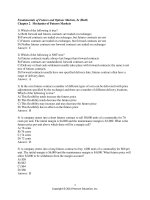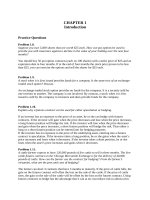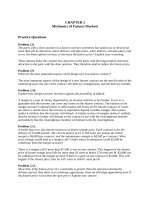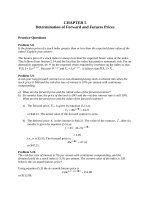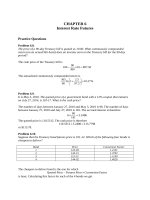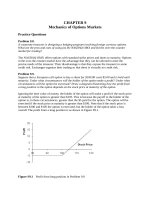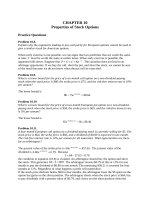Fundamentals of futures and options markets 8th edition hull test bank
Bạn đang xem bản rút gọn của tài liệu. Xem và tải ngay bản đầy đủ của tài liệu tại đây (171.04 KB, 4 trang )
Fundamentals of Futures and Options Markets, 8e (Hull)
Chapter 2 Mechanics of Futures Markets
1) Which of the following is true?
A) Both forward and futures contracts are traded on exchanges
B) Forward contracts are traded on exchanges, but futures contracts are not
C) Futures contracts are traded on exchanges, but forward contracts are not
D) Neither futures contracts nor forward contracts are traded on exchanges
Answer: C
2) Which of the following is NOT true?
A) Futures contracts nearly always last longer than forward contracts
B) Futures contracts are standardized; forward contracts are not
C) Delivery or final cash settlement usually takes place with forward contracts; the same is not
true of futures contracts
D) Forward contracts usually have one specified delivery date; futures contract often have a
range of delivery dates
Answer: A
3) In the corn futures contract a number of different types of corn can be delivered (with price
adjustments specified by the exchange) and there are a number of different delivery locations.
Which of the following is true?
A) This flexibility tends increase the futures price
B) This flexibility tends decrease the futures price
C) This flexibility may increase and may decrease the futures price
D) This flexibility has no effect on the futures price
Answer: B
4) A company enters into a short futures contract to sell 50,000 units of a commodity for 70
cents per unit. The initial margin is $4,000 and the maintenance margin is $3,000. What is the
futures price per unit above which there will be a margin call?
A) 78 cents
B) 76 cents
C) 74 cents
D) 72 cents
Answer: D
5) A company enters into a long futures contract to buy 1,000 units of a commodity for $60 per
unit. The initial margin is $6,000 and the maintenance margin is $4,000. What futures price will
allow $2,000 to be withdrawn from the margin account?
A) $58
B) $62
C) $64
D) $66
Answer: B
1
Copyright © 2014 Pearson Education, Inc.
6) One futures contract is traded where both the long and short parties are closing out existing
positions. What is the resultant change in the open interest?
A) No change
B) Decrease by one
C) Decrease by two
D) Increase by one
Answer: B
7) Who initiates delivery in a corn futures contract?
A) The party with the long position
B) The party with the short position
C) Either party
D) The exchange
Answer: B
8) You sell one December futures contracts when the futures price is $1,010 per unit. Each
contract is on 100 units and the initial margin per contract that you provide is $2,000. The
maintenance margin per contract is $1,500. During the next day the futures price rises to $1,012
per unit. What is the balance of your margin account at the end of the day?
A) $1,800
B) $3,300
C) $2,200
D) $3,700
Answer: A
9) A hedger takes a long position in a futures contract on a commodity on November 1, 2012 to
hedge an exposure on March 1, 2013. The initial futures price is $60. On December 31, 2012 the
futures price is $61. On March 1, 2013 it is $64. The contract is closed out on March 1, 2013.
What gain is recognized in the accounting year January 1 to December 31, 2013? Each contract
is on 1000 units of the commodity.
A) $0
B) $1,000
C) $3,000
D) $4,000
Answer: D
10) A speculator takes a long position in a futures contract on a commodity on November 1,
2012 to hedge an exposure on March 1, 2013. The initial futures price is $60. On December 31,
2012 the futures price is $61. On March 1, 2013 it is $64. The contract is closed out on March 1,
2013. What gain is recognized in the accounting year January 1 to December 31, 2013? Each
contract is on 1000 units of the commodity.
A) $0
B) $1,000
C) $3,000
D) $4,000
Answer: C
2
Copyright © 2014 Pearson Education, Inc.
11) The frequency with which margin accounts are adjusted for gains and losses is
A) Daily
B) Weekly
C) Monthly
D) Quarterly
Answer: A
12) Margin accounts have the effect of
A) Reducing the risk of one party regretting the deal and backing out
B) Ensuring funds are available to pay traders when they make a profit
C) Reducing systemic risk due to collapse of futures markets
D) All of the above
Answer: D
13) Which entity in the United States takes primary responsibility for regulating futures market?
A) Federal Reserve Board
B) Commodities Futures Trading Commission (CFTC)
C) Security and Exchange Commission (SEC)
D) US Treasury
Answer: B
14) For a futures contract trading in April 2012, the open interest for a June 2012 contract, when
compared to the open interest for Sept 2012 contracts, is usually
A) Higher
B) Lower
C) The same
D) Equally likely to be higher or lower
Answer: A
15) Clearing houses are
A) Never used in futures markets and sometimes used in OTC markets
B) Used in OTC markets, but not in futures markets
C) Sometimes used in both futures markets and OTC markets
D) Always used in both futures markets and OTC markets
Answer: C
16) A haircut of 20% means that
A) A bond with a market value of $100 is considered to be worth $80 when used to satisfy a
collateral request
B) A bond with a face value of $100 is considered to be worth $80 when used to satisfy a
collateral request
C) A bond with a market value of $100 is considered to be worth $83.3 when used to satisfy a
collateral request
D) A bond with a face value of $100 is considered to be worth $83.3 when used to satisfy a
collateral request
Answer: A
3
Copyright © 2014 Pearson Education, Inc.
17) With bilateral clearing, the number of agreements between four dealers, who trade with each
other, is
A) 12
B) 1
C) 6
D) 2
Answer: C
18) Which of the following best describes central clearing parties?
A) Help market participants to value derivative transactions
B) Must be used for all OTC derivative transactions
C) Are used for futures transactions
D) Perform a similar function to exchange clearing houses
Answer: D
19) Which of the following are cash settled?
A) All futures contracts
B) All option contracts
C) Futures on commodities
D) Futures on stock indices
Answer: D
20) A limit order
A) Is an order to trade up to a certain number of futures contracts at a certain price
B) Is an order that can be executed at a specified price or one more favorable to the investor
C) Is an order that must be executed within a specified period of time
D) None of the above
Answer: B
4
Copyright © 2014 Pearson Education, Inc.
